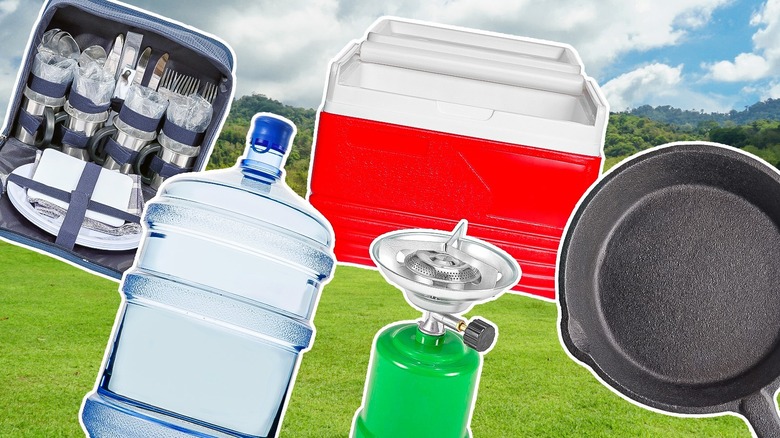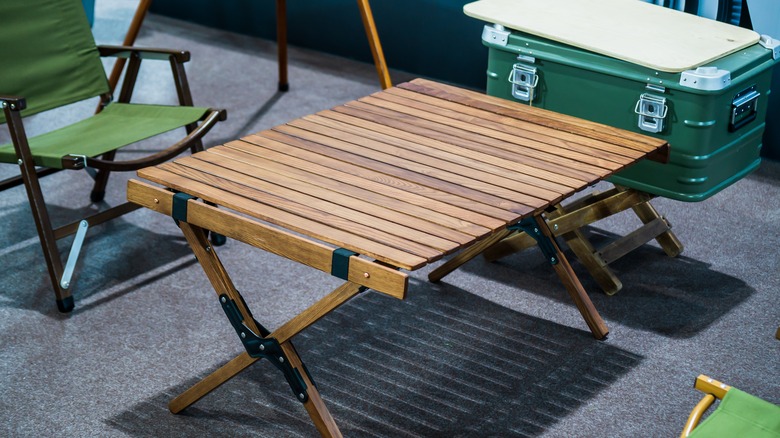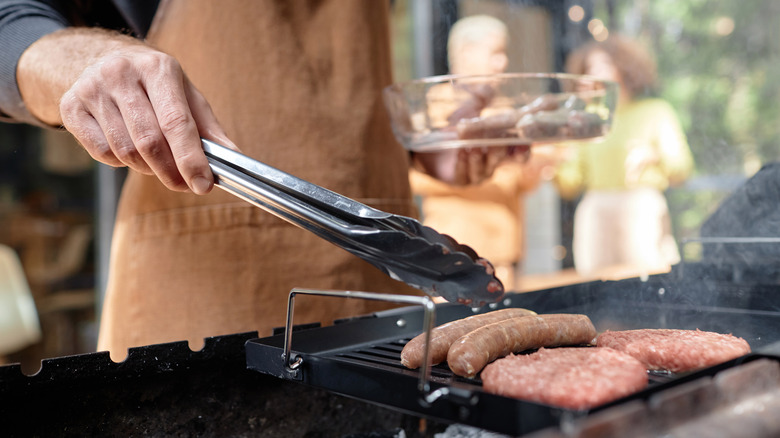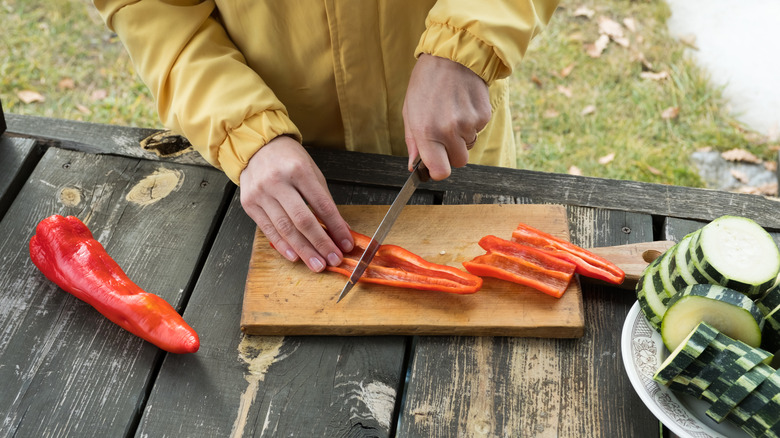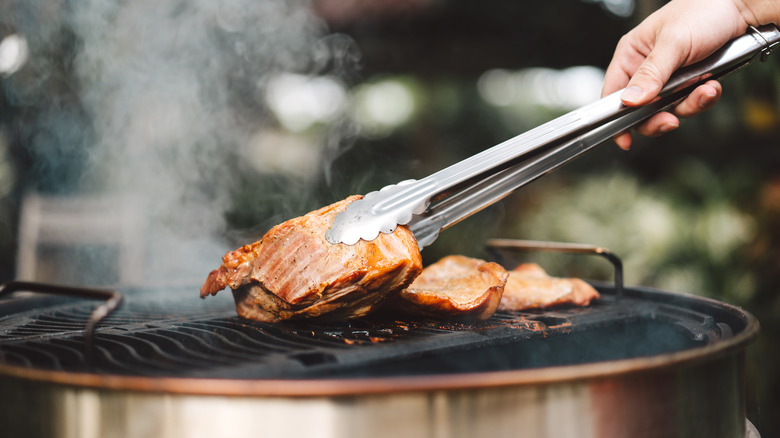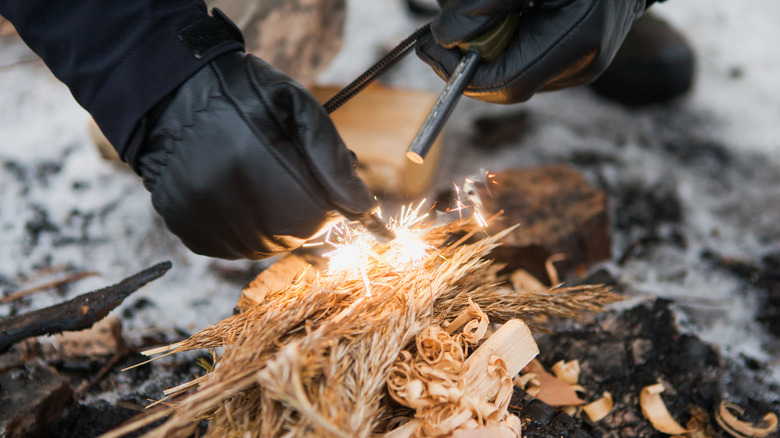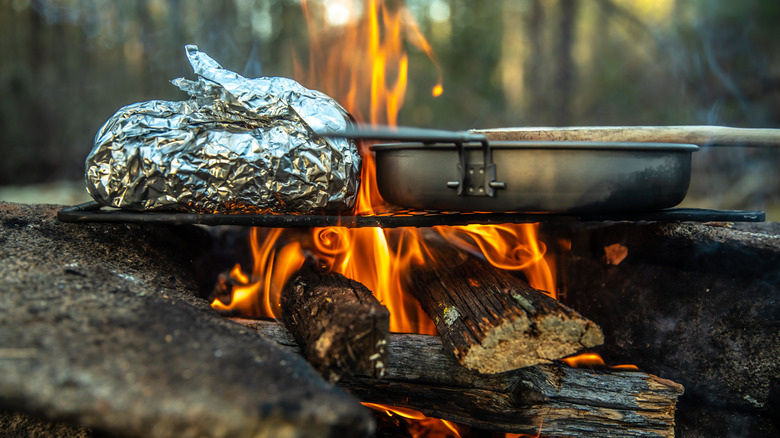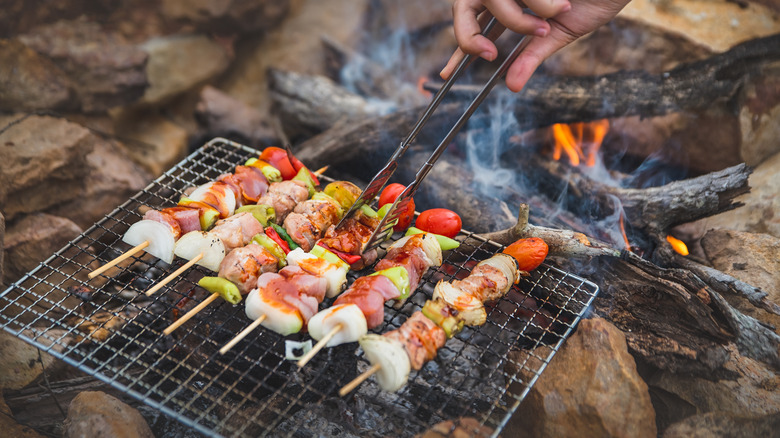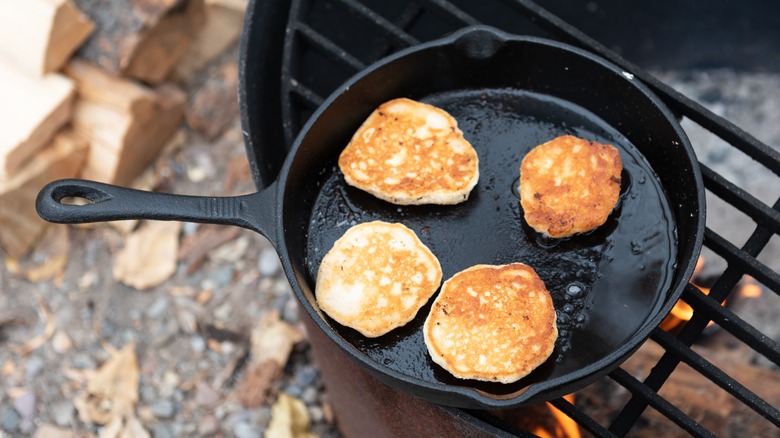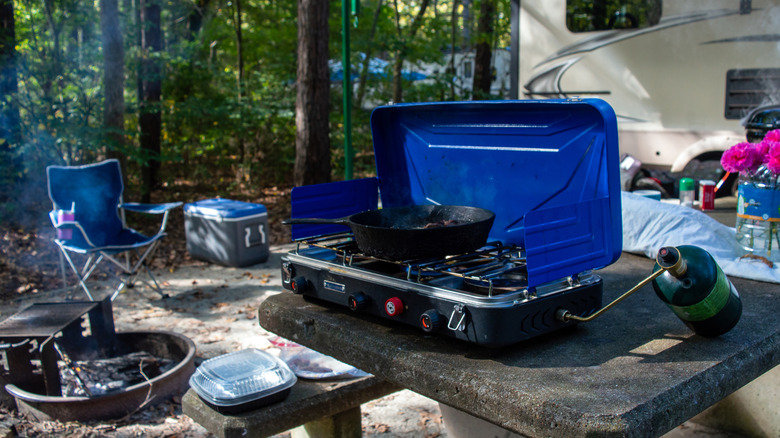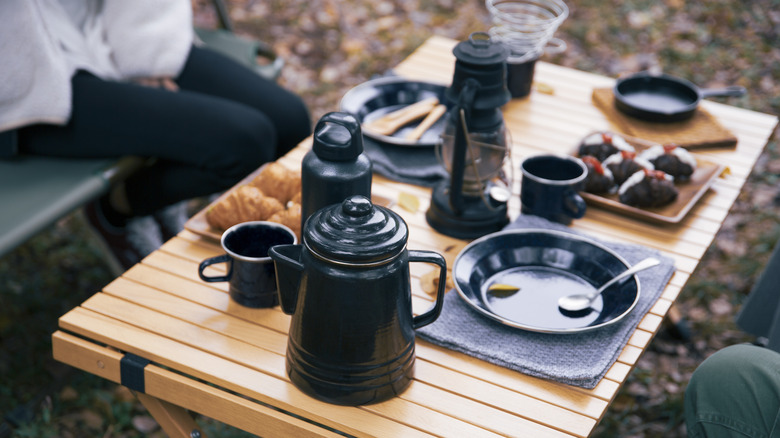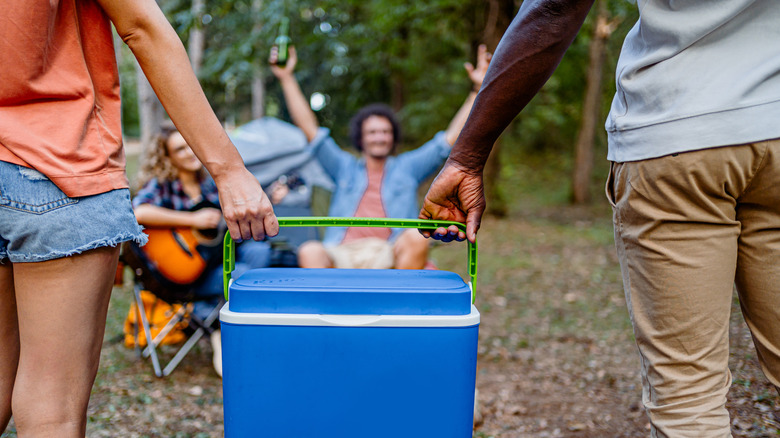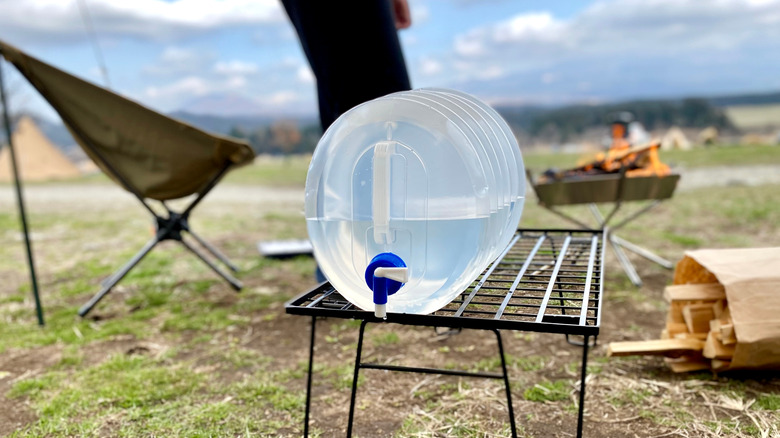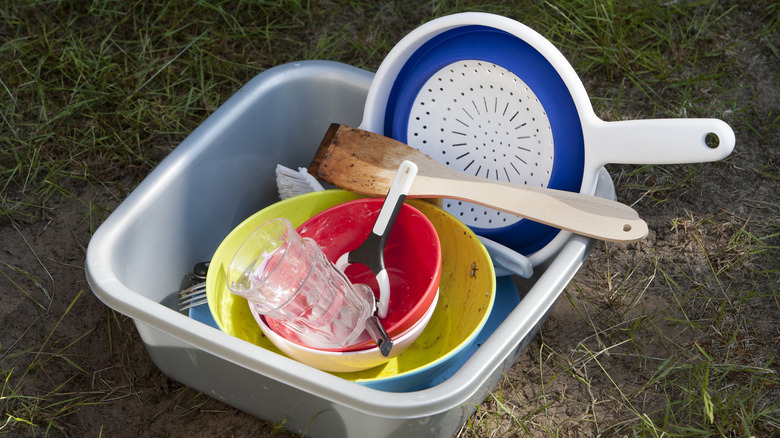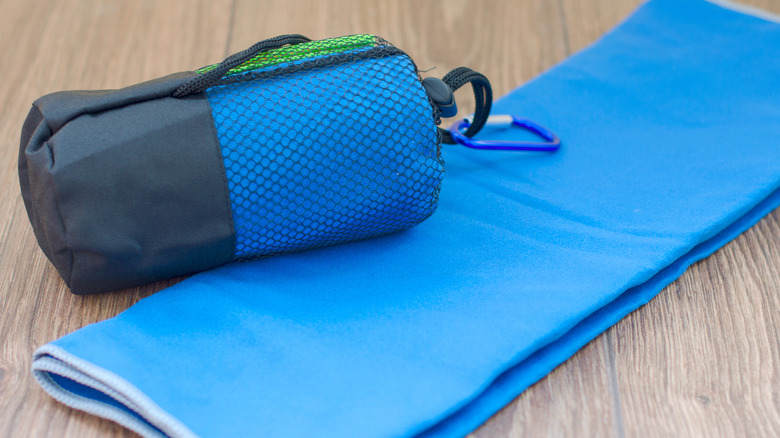14 Cooking Essentials Seasoned Campers Recommend For Your Next Trip
Packing can be overwhelming in general, but this is especially true when camping. Layered clothing, first aid items, sleeping gear, and more make for a lengthy checklist. But to slim down your camp kitchen and ensure your trunk closes shut, I consulted three outdoor cooking experts.
These include Cody Rydin, executive chef of Aspen Skiing Company, and chef Carson Kennedy of Home Team BBQ Aspen. On July 27, 2024, they participated in Heritage Fire Snowmass, an open-air food festival that centers around live-fire cooking — namely that of heritage-breed livestock and produce. The touring event also spotlighted local chefs and producers in destinations including Napa, California on August 18 and Miami, Florida on November 10.
Additionally, I spoke with former NFL player Bobby Massie, who recently co-founded Colorado-based outfitter Wanderland Outdoors with his wife, Angel. She and other guides oversee fly fishing excursions, horseback rides, and mindful hiking experiences. Meanwhile, Bobby manages the company's culinary program, crafting and personally cooking multi-course menus inspired by local ranches, waterways, and gardens. In the near future, he hopes to incorporate Indigenous foods associated with Colorado's Ute history, as cultural competency is one of the Black-owned business' core values.
Finally, you'll gain a few insights from me: a knowledgeable camper who's pitched tents all over the United States. I've made countless meals outdoors and help fill in the gaps for cooks more accustomed to tanks of propane. Regardless of your skill set, remember these cooking essentials for your next camping trip.
Portable table
Many campsites feature large picnic tables, but that isn't always the case. Even if there is one, it may be bolted down away from the fire pit or set in the direct sun — which is not a good place for raw meats to be for long. For these reasons, Bobby Massie believes that a portable prep table is a must-have, and Carson Kennedy adds, "Camping particularly is an area where packing light can help simplify the task."
Keep that in mind when selecting a table. It should fold down flat for easy packing into your vehicle, or roll up tight like my camp table I got from L.L. Bean. I especially like it because there's a mesh net underneath, perfect for storing and accessing other cooking essentials. Mise en place, even when your kitchen is outdoors.
Along with being compact, you should consider the table's size and the number of people you'll generally cook for. Obviously, the space needed to prep two versus 10 meals is a considerable difference. Also, steer away from tables with hardware that could trap sand or dirt. Sliding height-adjustable legs are notorious for this. And finally, opt for a heat-resistant aluminum table top because plastic and open fires should not mix.
Cooking apron
According to Carson Kennedy, "A solid apron made out of heavier material can be great if cooking near an open fire in large quantities." There's no doubt the chef wore one behind the Home Team BBQ booth at Heritage Fire Snowmass, where he fed hundreds of attendees.
But even if you're just cooking for a few friends, this tip applies. After all, you're packing light when camping, and you don't want spills and splashes to soil one of the few outfits you have on hand. Additionally, real cooks wear aprons for protection against excessive heat and hot surfaces, which are unavoidable hazards when cooking with fire. Plus, they allow you to have towels and utensils within reach when you need them.
Durable aprons are made with materials like leather and denim, but wax-coated canvas is especially ideal. Not only is this type of fabric protective, but it wipes clean in a flash.
Cutting board and knives
When cooking outdoors, Cody Rydin recommends packing a good knife. Carson Kennedy suggests bringing a couple, and Bobby Massie says to go all in with the full set. Really, what's on the menu will determine your ideal number of knives and, as Rydin notes, "The most important [essential is] a good hunt or catch."
If you plan to fry up the trout you caught earlier in the day, a fillet knife will come in handy. If you're cooking a whole animal or large pieces of meat, other types of knives will make the job easier. Even those that are more "gatherer" than "hunter" can benefit from a sharp, reliable blade to slice through thick watermelons and tough asparagus spears.
As far as your cutting board, avoid easy-to-melt plastic and definitely do not use a glass cutting board outdoors. "You never know when something might break, and nobody wants a bunch of broken glass around their camping [or] cooking site," explains Kennedy. Rather, he favors a wood cutting board both to butcher and display a meal. He says, "Something about cooking on open fire tends to bring out an incredible communal aspect," and this serving style will help accomplish just that. Plus, re-using a cutting board means fewer dishes.
Cooking utensils kit
"One of the most important things for me when cooking outdoors are proper utensils," says Carson Kennedy, clarifying that it's "better to have a couple of quality utensils than a huge variety of things that you might not need."
For him, the bare-bone essentials are a large spatula and a pair of long tongs. He explains, "Many an outdoor cook has singed off some arm hair by using short utensils and getting too close to a flame!" To avoid the same mistake, make sure that the tongs you pack measure at least 18 inches in length, which will allow you to safely reach into and over an open fire. If you're cooking animal proteins, a meat thermometer will also prove useful.
But, of course, you should also consider your own meal plan. As someone who largely eats plant-based, a can opener is one of my must-haves — how else will I break into my tin of beans? But, to Kennedy's point, aim to be minimalist. Skip the soup ladle and use a regular dinner spoon, and simply whisk tomorrow morning's scrambled eggs with a fork to limit your packing list.
Fire striker and fire starters
While a simple pocket lighter can generally get a bonfire going, you never know when the weather might turn. Stormproof matches are reliable, even in windy conditions, heavy rain, and snow. But Cody Rydin suggests packing a reusable fire striker which involves two pieces: a rod made from ferrocerium and a stainless steel plate. To start a fire, you point the ferro rod a few inches away from your tinder, then apply pressure as you quickly scrape the steel plate down the rod. This action results in a spray of sparks which will quickly ignite various types of fire starters. Flint and steel can create the same effect, but are less user-friendly — and to Bobby Massie's point, cooking outdoors should be a primitive, yet comfortable experience.
Similarly, he recommends avoiding lighter fluid when cooking outdoors and explains, "There are much cleaner ways to get your fire going, from fire starter bundles to a bag of Doritos!" You read that right — Doritos are good campfire tinder. The chips' salt content keeps them dry, while flammable ingredients like cornstarch and vegetable oil burn hot and long enough for tinder to catch.
However, if you want to save your chips for snacking, arrive prepared with fire starter bundles, which are wound-up wood shavings coated in wax. They're all-natural, lightweight, easy to ignite, and sold in a variety of retailers. Other natural fire starters include Lightning Nuggets, as well as fire sticks and fire starter points.
Firewood and rocks
When it comes to camp cooking essentials, Cody Rydin says that "proper dry wood to burn" is high on his list. But first thing's first: Always look up local fire restrictions before sparking up a bonfire. Even where fires are allowed, temporary bans may occur, especially during periods of drought or high winds. Some areas may only allow fires in designated pits and not all allow firewood collecting. Even when trees are downed and dead, they provide food and shelter to wildlife. Additionally, you should never cut down branches from a live tree. Not only is this an environmental no-no, but they're saturated with sap and won't burn, anyway.
Instead, purchase firewood bundles locally. Buying from a retailer near your campsite helps prevent the spread of invasive insects, fungi, and other diseases which may threaten a forest. Bundles also often come with both kindling and logs, which help to create a well-built campfire.
Rydin adds that rocks are another must-have, as they can "create a base for cooking equipment, whether it's a rack or rebar to suspend from." For a truly primitive experience, you can even use a large, flat rock slab as a cooking surface when working over an open flame. But keep in mind that even the embers from your campfire make for great outdoor cooking.
Bare-bones grill rack
With the help of a fire striker and starter, sparking a flame is easy. But strategically constructing a bonfire to prevent food from burning takes a bit of technique. Understanding how to use direct versus indirect heat is one of many other important tips for cooking dishes over a campfire. The type of cookware you use can make a big difference, too.
Bobby Massie prefers working with a bare-bones grill rack when cooking outdoors. Remember, pack light and compact whenever you can. A simple metal slotted grate works well for many of the best foods to roast over a campfire, from freshly-caught fish and cuts of beef to summer vegetable skewers. With the right timing and temperature, you'll get those gorgeous sear lines and the perfect amount of char on your meal, along with a pleasant smokey flavor. Kennedy says that seasoning always takes things up a notch but again, no need to overpack. Cody Rydin swears by simply salt, pepper, and oil.
Frying pan
While grilling is a classic way to cook outdoors, some camping recipes require a cooking vessel — and none are as versatile as a deep frying pan. Sure, it may be a bit strange to simmer chili in a skillet, but it's way less cumbersome than packing your entire set of pots and pans.
In narrowing it down to one, Carson Kennedy recommends a cast iron pan. Though heavy, it's durable and does a great job of retaining heat. Plus, when properly seasoned, cast iron pans prevent food from sticking, allowing for a better cooked meal and less dish scrubbing. They aren't the deepest of options, but work well for many campsite classics including pulled pork, campfire nachos, breakfast scrambles, and pancakes.
If your meal demands more volume, try using a wok for creative outdoor cooking. Famed restaurateur Guy Fieri endorses this unique choice and reminds campers not to limit themselves to the usual menu of burgers and hot dogs. After all, many camping and backpacking meal brands take inspiration from global flavors, with options like pad Thai and Kung Pao chicken often appearing on outdoor retailers' shelves.
Camp stove and fuel
These interviewed expert chefs like to keep things primitive with an open fire. But those with less outdoor cooking experience may benefit from a fuel-powered camp stove. Sure, some may consider it unnecessary. But even grill masters will find one convenient when it's a chilly morning and they're aching for a hot cup of coffee, stat.
I love my Jetboil Flash cooking system when backpacking, as it boils water in just a matter of minutes. But if you envision car camping most of the time, I think a Coleman classic camp stove is among the best portable cooking gear. Simply hook it up to a 16-ounce propane tank and fire up its two burners — no survival skills required. However, make sure to pack a lighter or matches, ideally those that are stormproof. Sparks from a fire striker are not the way to light a camp stove.
Camp table set and cutlery
Cooking outdoors requires more effort than at home and after putting in the work, Cody Rydin believes that "enjoying the meal is a large part of the experience." He says, "Bringing in disposable plate ware and cutlery is unnecessary, not only for the disposable aspect, but the vibe of the event."
By no means do you need a whole Pinterest-worthy picnic display, but real dishes and cutlery are essential. Many styles are sold as sets but at a minimum, be sure to pack plates, drinkware, forks, and knives with a reasonable edge. Depending on your meal plan, bowls and spoons may also come in handy.
Enamel is a popular material choice, as it's durable, lightweight, and easy to clean. Plus, it looks and feels more high-end than plastic and silicone which, when it comes to camping table sets, are often the alternative. Of course, you can always pack your usual day-to-day dishes and flatware but remember, glass should always be avoided on a campsite.
Cooler and ice
While an obvious essential, there are several things you should know before buying a cooler. For example, there are many sizes on the market to consider and models with wheels may be easier to cart to a campsite. Soft-sided coolers may be ideal to pack in your vehicle and store in your home, while those that are hard-sided often do a better job of keeping the ice in your cooler from melting too fast.
You also need to take your budget into account. But if you're going camping, you probably value the outdoors — and oftentimes, you can better protect the environment by buying a product for life. While a bit of an investment, I've had my Cabela's Polar Cap cooler for years and am amazed at how it keeps just regular-sized ice solid for several days, even with frequent opening and closing in the summer heat. With a quality cooler, you won't have to worry about food spoiling and can spend more time at your campsite, rather than driving to the nearest town for yet another bag of ice.
Water jug
You may notice a spigot at your campground marked as having potable water. This means that the water is safe to drink, although it may be well water and have a mineral flavor you're not used to. Meanwhile, other campgrounds don't have this amenity, making it especially important to pack your own water.
Cody Rydin says that when cooking outdoors, trash should be avoided whenever possible. Both for environmental and practical reasons, skip the single-use gallon jug at the grocery store and instead purchase a reusable jug that can hold significantly more. Between drinking, cooking, and washing dishes, you'll go through water faster than you might think.
Certain models are hard-sized, while others are collapsible for easy storage and packing. Even some of the 5-gallon jugs you see on top of water dispensers are reusable and BPA-free. With the use of a portable pump attachment, they're especially convenient for conserving water as liquid is dispensed in a thin stream at the touch of a button. Comparatively, some water jugs' twist-lock spigots can be trickier to control when all you need is a quick splash.
Camp sink and biodegradable dish soap
Some campgrounds have designated camp sinks, but most do not have this luxury. For this reason, it's important to pack one — but in my opinion, the camp sinks built into tables are a bit overkill. Really, all you need is a bin. Repurpose a plastic storage box laying around in your garage or buy a collapsible camp sink for packing ease.
Camp sinks and biodegradable dish soap align with Leave No Trace ethics, which inform folks how to protect and preserve wild places. One of its principles is to dispose of waste properly. Once you finish doing your dishes, you should use a strainer to catch any bits of food in your camp sink as you disperse the wastewater. Be sure to do this a good distance from your campsite, especially if you're in bear country. Dump the muck in your strainer into a trash bag and always dispose of it in a proper receptacle.
Quick-drying towels
Avoid the trash from paper towels and instead, bring cloth towels which can serve a variety of purposes. Cody Rydin notes that they make for great hot pads and, of course, they're handy for cleaning up messes and drying dishes, too. You could pack the cotton dish towels you use at home but there's a solid chance they'll still be a bit damp in the morning, especially if you're camping in humid conditions.
Rather, I recommend purchasing at least a couple of quick-drying towels for your campsite kitchen. Often made from polyester and nylon, they're lightweight and super compact. They're also highly absorbent yet, just by tightly wringing them out, they'll be nearly dry and ready to fold back into your camping kit. Especially when you're packing light and each item counts, it's important to stay organized — and the sooner gear goes back right where it should, the better.
